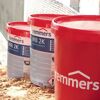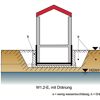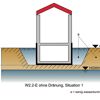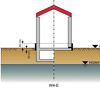With the introduction of the new water impact class W4-E, clear requirements are defined for the structural waterproofing products in and under walls below ground level. For example, it is stated that the selected waterproofing type must be able to break off vertical loads without damage and must show sufficient strength against horizontal loads. Both conditions are met in accordance with DIN 18533 for crack-bridging mineral waterproofing slurries.
The effectiveness and durability of building waterproofing depends on expert planning and installation. Since the summer of 2017, designers and installers have been using the new DIN 18533 standards as a basis for waterproofing building components below ground level.
The restructuring of the national standards for ground-based waterproofing includes systems not only proven in practice, but now also non-established types and a new, clear structure has been created.
Structure:
Part 1: Requirements, planning and installation principles
Part 2: Waterproofing with membrane materials
Part 3: Waterproofing with liquid waterproofing materials
Part 3 of the DIN 18533 specifies the requirements for liquid waterproofing materials to be processed. In particular these include:
- Polymer modified, bituminous thick coating (PMBC)
- Crack-bridging mineral waterproofing slurries (MDS)
Basic principles for selecting waterproofing systems
The effectiveness and reliability of waterproofing of buildings can only be guaranteed if the selected waterproofing type shows sufficient resistance to external influences. In Part 1 of the Standard, the most important effects on waterproofing below ground level are classified according to the following characteristics.
Water in the shape of capillary water, moisture or ground water can impact on the waterproofing that is in contact with the ground. The highest water level measured, the surface terrain and the type of ground are decisive when defining the water impact class (Wx-E). To determine the permeability of the ground, it is generally necessary to define the water permeability coefficient (K value).
Cracks or changes to crack widths from the substrate must not cause damage to the waterproofing. To take this reliability criterion into account, the standard defines four different crack classes (Rx-E) depending on typical waterproofing surfaces. The sealing material must be selected depending on the crack classes determined for the object. The selected waterproofing material must have the required crack-bridging class.
Dependant on the utilisation of the basement space, the room climate and/or room air present must be taken into consideration. Based on the classification for the use of the space, the waterproofing type and/or the permitted waterproofing material are determined.

Remmers waterproofing products pave the way!
A number of Remmers waterproofing systems that have been recommended for years are covered by the new DIN 18533 standard. For instance, polymer modified, bituminous thick coatings, such as Remmers PBD 2K and Bit K2, can now be used as waterproofing against water that is below ground level. Previously, this was only possible if there was a special agreement. The areas of application for crack-bridging mineral sealing mortar (MDS) have also been considerably expanded. Remmers MB 2K+ meets the test conditions for crack-bridging MDS and is therefore is not only suitable to cover the water impact class W4-E that is specially designed for the base area, but can also be used as waterproofing to prevent ground moisture and damp on concrete structures below ground without a special agreement.
Due to its extensive range of properties, Remmers MB 2K+ also remains in a class of its own in areas of application outside of the defined standards..
Reliability, fast and easy processes along with short waiting times are the most importanat aspects that a modern waterproofing system has to fulfill. Lots of professionals want to complete the waterproofing work in one day and continue working the next day. Remmers waterproofing systems perfectly meet these requirements.
Base seals are usually made with mineral waterproofing grouts. However, they have one major disadvantage; they only adhere to mineral surfaces. This means that in the case of new construction, they must be installed below ground level before the bitumen-based waterproofing. This is not the case with the new MB 2K+: This product combines the properties of a crack-bridging, mineral water proofing grout with that of a and polymer modified, bitumen coating.
Waterproofing new buildings
13 products foundView:
Article No. 507101
High-quality, premium sealing tape based on nitrile rubber and coated with non-woven fabric
Article No. 500301
Highly elastic, self-adhesive butyl rubber waterproofing tape on polypropylene non-woven fabric
Article No. 082301
Highly durable, 3-layer protective sheet with decoupling function
Article No. 417601
Reinforcement fabric made of E-glass with polymer plastic sheathing


















![WP DKS rapid [basic] WP DKS rapid [basic]](https://m.remmers.com/gebindeabbildungen/2400w/81238.png?version=0&w=100)




